Family : Coccinellidae

Texte © Dr Didier Drugmand

English translation by Mario Beltramini
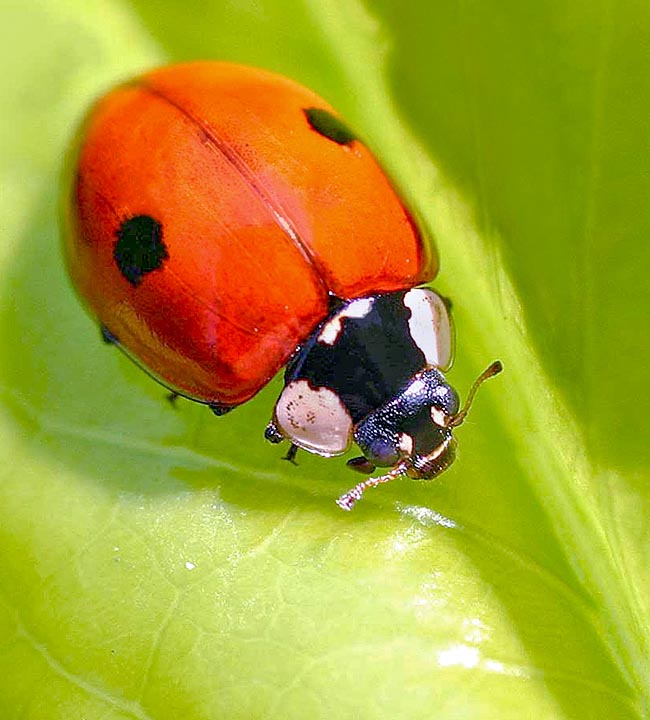
The Two-spot ladybird (Adalia bipunctata) is undoubtedly among the most spread and studied ladybirds in the world © Claude Galand
The genus Adalia is present in Europe with 6 species now distributed in two sub-genera: Adalia Mulsant, 1846 and Adaliomorpha Iablokoff-Khnzorian, 1979.
The species object of this work is the Adalia (in the strict sense) bipunctata, known in France under the vulgar name of Coccinelle à deux points.
It was the Swedish scientist Carl Linnaeus who has described it briefly for the first time in 1758, to place it in the genus Coccinella. Five words have been sufficient to him for describing it “Coleoptris rubris : punctis nigris duobus” that is, red Coleopter with two black spots. He then concluded assigning it to Europe and limiting its biotope to the alder.
The etymology of the name Adalia is not easily established. This term might derive from the name of “Adaliah”, a biblical character connected to the term Adam with the meaning in Hebrew of “done with red earth”, with reference to the colour of the elytra of this ladybug. The name of the species bipunctata conversely is composed by the Latin prefix “bi” = two and by “punctatus” = spotted, pointed, a simple reference to the two points present on the elytra.
The British employ many names for describing the Adalia bipunctata : Two-Spot Ladybird, Two-Spotted Ladybug or Two-Spotted Lady Beetle. In the Netherlands it is known with the nickname of Tweestippelig lieveheersbeestje, in Germany as Zweipunkt-Marienkäfer, in Italy Coccinella dai due punti and in Spain as Mariquita de dos puntos.
Zoogeography
The Two-spot ladybird is amply distributed in the European, Asian and also Oceanic Palearctic, occupying completely the territory from its western limit and to the south up to Australia and New Zealand. It has been also observed in the North-American and South-American regions but these data must be confirmed. It is also present in small numbers in North Africa, as well as in Iceland, the Açores and Gibraltar, where its presence is however uncertain, probably due to the absence of further observations. We have to note that in western Europe the morpho-chromatic difference, of which we shall treat further ahead are fruit of hybridizations with the type form.
Ecology-Habitat
In Europe the Two-spot ladybird is one of the most diffused species and consequently also the most studied, being rightly an eurytopic species. It stands in fact in a plurality of environments, urban as well as rural and frequents numerous herbaceous species, shrubby and also woody. So much that in the United Kingdom the larvae have been collected in up to 180 vegetal taxas! The arboreal species most frequented include trees such as maples, limes, oaks, birches and willows, spiny shrubs such as the hawthorn, the brambles and the small fruit trees, ruderal plants like the nettles, the thitles and some Apiaceae, marsh plants and even ornamental.
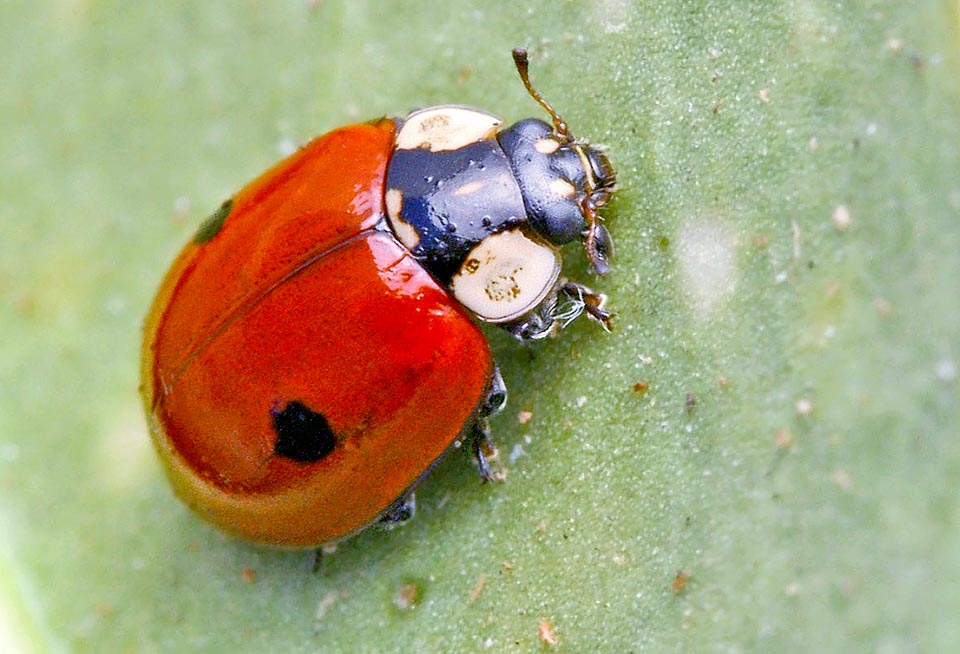
The larvae of Adalia bipunctata have been found on about 180 species of plants. The choice preys are aphids but it eats also other small insects, such as for instance the cochineals, the acarids, the nectar and the pollen of the flowers without forgetting the molds. It has colonized, adapting, a huge variety of environments, urban and rural © Claude Galand
In autumn the last observations of this ladybird reach the end of October, when, after having stored the reserves of fat and of glycogens, they get ready for the winter diapause.
In rural zones this ladybird has the habit to hibernate in the dwellings, inside of which they create remarkable concentrations, in particular near the windows. These groups may be found on small groups also in external spaces, in the fissures of the trees, under the bark or also in cavities in the ground hidden by humus. Their awakening is very precocious since the beginning of spring (even by the end of winter when the climate gets less inclement). In Europe, depending on the latitude and on the climate conditions, the ladybird is univoltine and at times bivoltine, with a first reproductive peak in early spring and a second by late summer.
The birds and some micro-mammals are its main predators whilst the adults and their preimaginal stages (eggs, the four larval stages and the nymph) are also attacked by the Coleopterans, mainly those belonging to the family of the Carabidae, of the Staphylinidae and of the Cantharidae.
Their predation is however reduced thanks to the Batesian mimicry linked to the aposematic colouration of the red of the elytra of the adults. Finally, it is to be noted that some diseases, increased by the multiple copulations, may also limit the number of the individuals, causing diffused sterility in the females (in some populations the 90% of the subjects are infected). Various species of laboulbeniaceous (Ascomycetes), of mites (Acari) and of dipterans (Phoridae) parasitize the Adalia bipunctata and have an impact more or less strong on its populations, depending on the location and the period of the year.
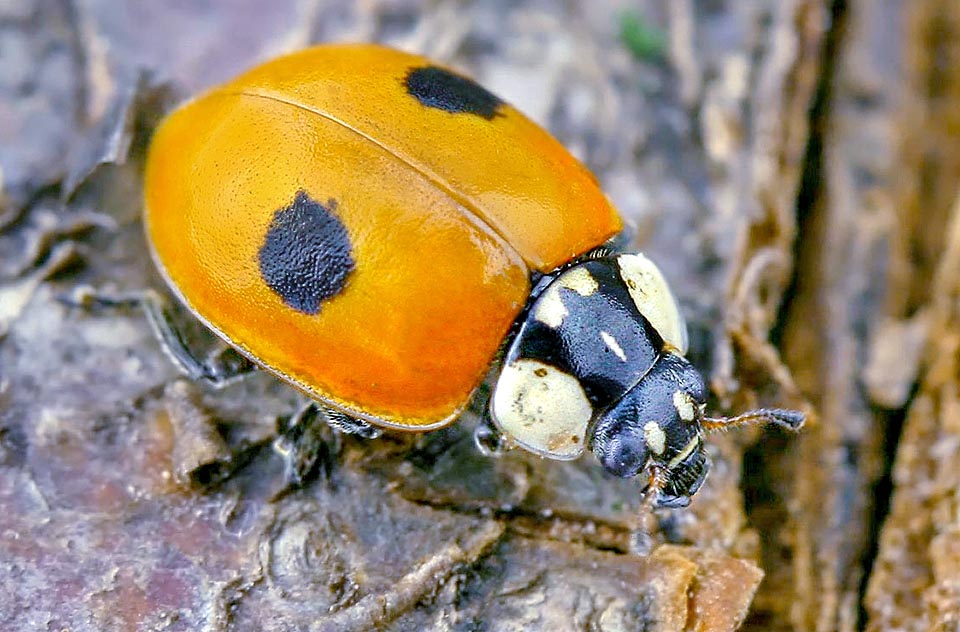
It is a polymorph species 3,5-5,7 mm long with at least 24 chromatic variants in Europe. Busy as they are with the mating the males eat less and consequently have a minor size than the females. Among them, the smallest ones, with less alimentary needs, ensure the survival of the species even in the periods of famine © Claude Galand
Morphophysiology
This polymorphic species has a length of 3,5-5,7 mm. In Europe have been remarked at least 24 chromatic (or morphisms) forms of the holotype. The colouration of the elytra of the Two-spot ladybird varies strongly and develops under different colourations going from the red to the black, controlled by different allelic frequencies that include not less than 11 alleles placed on a same locus.
All these chromatic forms appear to be interfertile and consequently cannot be considered as subspecies of the nominal form and much less of the species.
The typical form has black head with two lateral white notches more or less extended, that elongate on the front and along the eyes up to the neck. Whitish pronotum with a black discal dot formed like an “M” that often varies passing from a simple “M” to a wide discal band that occupies all the length of the pronotum. Dark or black scutellum, little visible, 15 times narrower than the length of the body. Ochraceous or red elytra, marked by two black dots of rounded or quadrangular shape.
The larvae are campodeiform, also with variable colouration, ave is usually is of slate grey colour. The head is black and the pronotum has three pairs of tubercles of the same colour. Abdomen with two lateral pairs of yellowish or orange tobercles on the first two segments and a median band, with irregular development, also clear on the following segments. Dark legs.
The nymph is similar to that of the Coccinella septempunctata and its colour varies strongly with a mix of orange colours and more or less extended black dots.
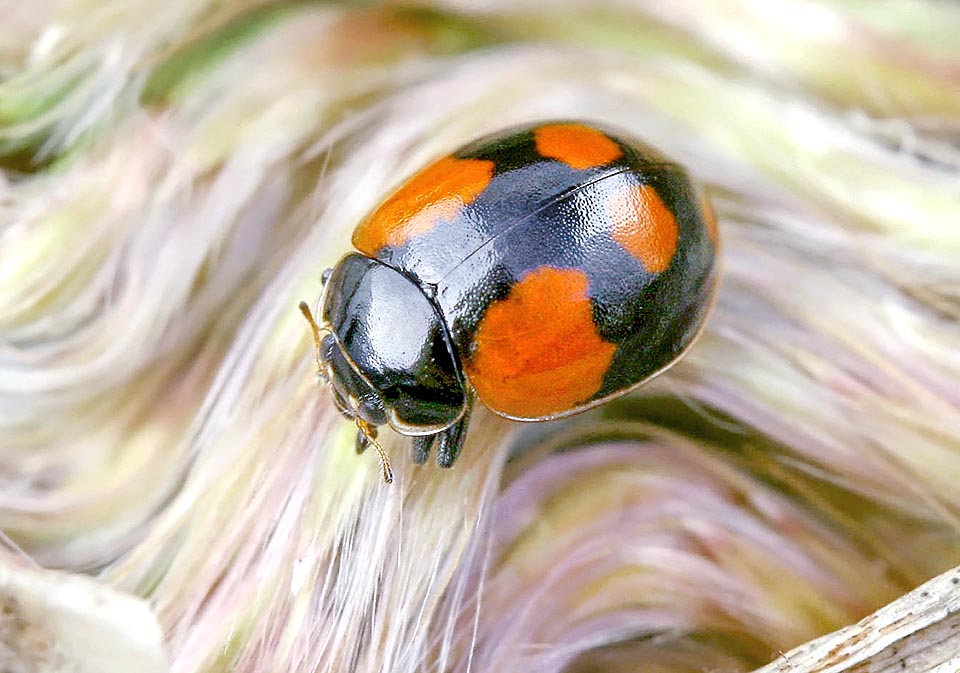
Melanic form of Adalia bipunctata. The elytra colour has very different variants between the red and the black. Some explain the dark shades as a mimetic adaptation to the city smog but it has been observed that, in difficult conditions, these animals are more active than the others, because they absorb quickly the sun energy © Claude Galand
At the extremity of the abdomen the larvae a gland producing a substance that facilitates the preservation of their surface, smooth and slippery. The size of the adults is variable and is directly related to the number of the preys ingested, their quality and the external temperature.
The chromatic polymorphism of the Two-spot ladybug (from the red forms to the black ones) has been studied by many European authors, as an aspect of thermal melanism. This theory sustains that in an ectodermal insect (that means that it does not produce heat or it does so only in a small quantity) the melanic forms warm up faster when the source of heat is limited and reach a higher equilibrium temperature if they are exposed to the sun. The insect by then will show up more active and a higher reproductive capacity.
This theory has been confirmed for the Adalia bipunctata. Other researchers see in the melanic forms also an adaptation to the polluted urban environment or a consequence due to environmental and evolutionary factors. This last hypothesis is still object of debate.
It is surely not easy to determine with certainty this species. Indeed, without passing through a genetic test, only the test of the aedeagus, the genital sclerotized structure of the male, allows with certainty to classify the males of the species. For the females, the determination of the base of the only outer characteristics is often difficult or impossible. In the preimago stages (that precede the adult stage) the breeding of the specimen will facilitate a correct classification.
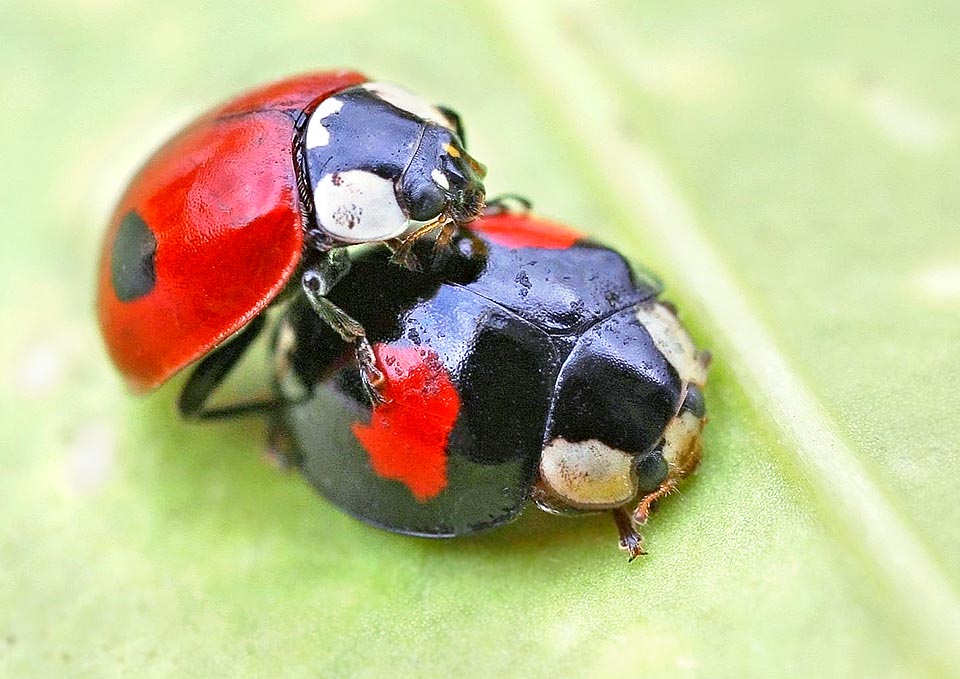
Normal male and melanic female. The mating lasts about 45 minutes. In some populations the females form the 80-90% of the members. This is due thanks to symbiont bacteria that in the interest of the species, kill most of the males in the laid eggs. They are less useful and the corpses offer an easy food to the female newborn larvae © Claude Galand
Ethology-Reproductive Biology
Adalia bipunctata is primarily aphidophagous. Among its choice preys we cite the Aphids among which mainly the Acyrthosiphon pisum (Pea aphid), Aphis pomi (Green apple aphid), Aulacorthum circumflexum (Mottle arum aphid) and Myzus persicae (Green peach aphid). To note that some species of aphids modify the development of the Adalia bipunctata if they represent a minimum of the 10 % of the total of the ingested preys. It is in this way that Aphis nerii (Oleander aphid) and Megouria viciae (Vetch aphid), obstruct the nymphosis whilst the Hyalopterus pruni (Mealy plum aphid) just to cite one, slows the growth of the ladybird. The Two-spot ladybird nourishes also of other Homopterans such as Psyllas and Cochineals. Some observers have seen it nourishing also of Chrysomelids (Coleopterans) and of Acarids (Acari).
The males, that are smaller than the females, ingest a third of the quantity of preys eaten by these last. The voracity of the larvae and of the adults depends on the abundance of the preys but varies depending on the temperature and increases when this last displays changes. In this way the consumption increases of a dozens of points when the temperature oscillates between the 8 and the 28 °C. If the food is missing, the Adalia bipunctata then migrate towards an area richer in palatable insects. This Ladybird may consume also nectar and pollen of the flowers but also molds.
Males and females live in promiscuity. The females reproduce with the strongest males and the energy cost of the reproduction appears higher for the females than for the males. Indeed, they must carry the male on the back during all the long phase of coupling (lasting about 45 minutes), period during which they cannot feed.
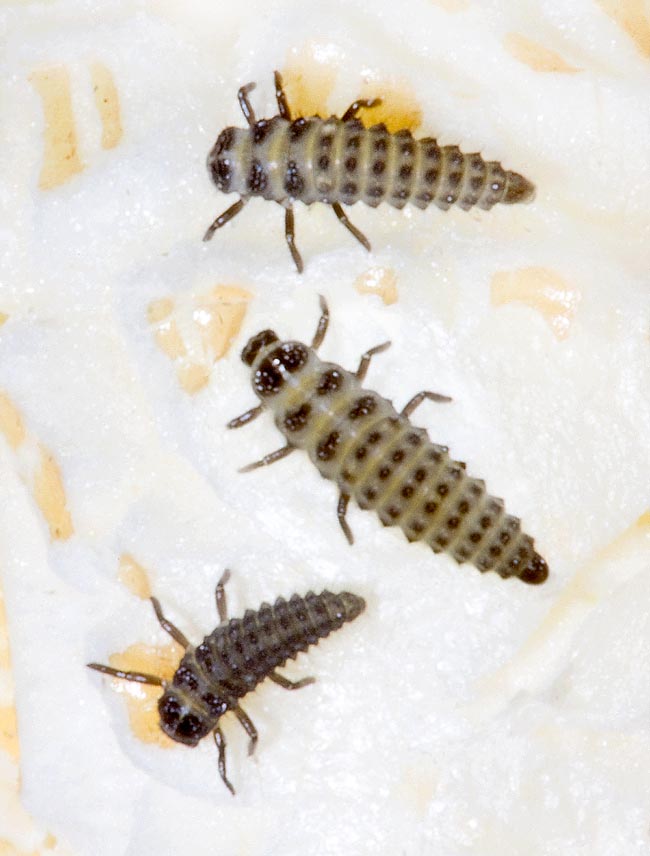
the Adalia bipunctata larvae are bred for the biological control. The biggest can devour even 66 aphids in one day, whilst adults, with lesser alimentary exigencies, are satisfied with an honourable average of 37-50 aphids per day © Giuseppe Mazza
It is also known that the females must copulate several times (also with different males) to fecundate all their ova and to realize this they copulate about 10 times more than the necessary. These behaviors clearly explain why the females consume more preys than their partners and are bigger than the males.
It seems that the smallest males are better reproducers than the big one, thus reinforcing the thesis “to eat or to mate” that implies a period of lack of food. In fact, they spend less time in eating and more in mating than what happens with the biggest ones.
The complete cycle of development, from the egg to the adult, requires in total from 25 to 59 days. In spring the stage of the egg lasts 3-7 days, the larval one (that includes 4 stages) 12-42 days and the nymphalid one 5-10 days. In summer the cycle is shorter and varies between the 15 and the 30 days.
In one year we count up to 28 depositions, more numerous after each copulation, and the fecundity decreases when the males get rare. The eggs are laid on the soil, in small packs of 5 to 30 eggs close to the preys.
In spring the females will lay their eggs mainly under the leaves of the trees and in summer also on herbaceous plants. After some authors, a female should yearly lay on the nettles from 700 to 1.500 eggs. This number varies enormously in function of the preys present and of their nutritional properties.
In order that a young larva may survive, it is necessary that the density of the preys exceeds the two aphids per 100 square cm. Normally, when the preys abound, between spring and autumn are present two generations and at times three. By the spring take off, often precocious, follows always a period of mating.
The number of the preys consumed grows with the age of the larvae, following a ratio of 1 : 2,4 : 3,7 : 6,6. In U.K. some studies have shown that a larva at the first stage consumes daily 7 to 16 aphids (depending on the species predated), those at the second 19 to 27 aphids, those at the third 26 to 46 and those at the fourth stage from 47 to 66 aphids, whilst the daily ration varies from 37 to 50 aphids.
The larvae at the first stage are attracted by the alarm pheromones emitted by the aphids when attacked by the oldest larvae or by the adults. This diet in group increases the probability that the young larvae survive and reach the next stage.
One fourth of the eggs of the Adalia bipunctata is eaten by the newborn larvae themselves and the cannibalism is directly connected with the density of the individuals. In spite of this it would appear that the adults and the larvae recognize themselves inside their community and that this cannibalism interests populations genetically distant.
In some populations the majority of the individuals is composed by females and the 80-90% of their progeny is also female. The reason of this anomaly explains with the presence of symbiotic bacteria living only inside the cells of the gametes of the female ladybirds. Seen that the bacterium is too big for living in the spermatozoa, it can be transmitted to the following generation only through the eggs. It is the cause of the death of most of the male embryos in the laid eggs, and these corpses will serve later on as food of their sisters just after the birth. This infection is associated to one or more species of bacteria (Wolbachia, Rickettsia, Spiroplasma) that are present, depending on the locations, from the 0 to the 20% of the females.
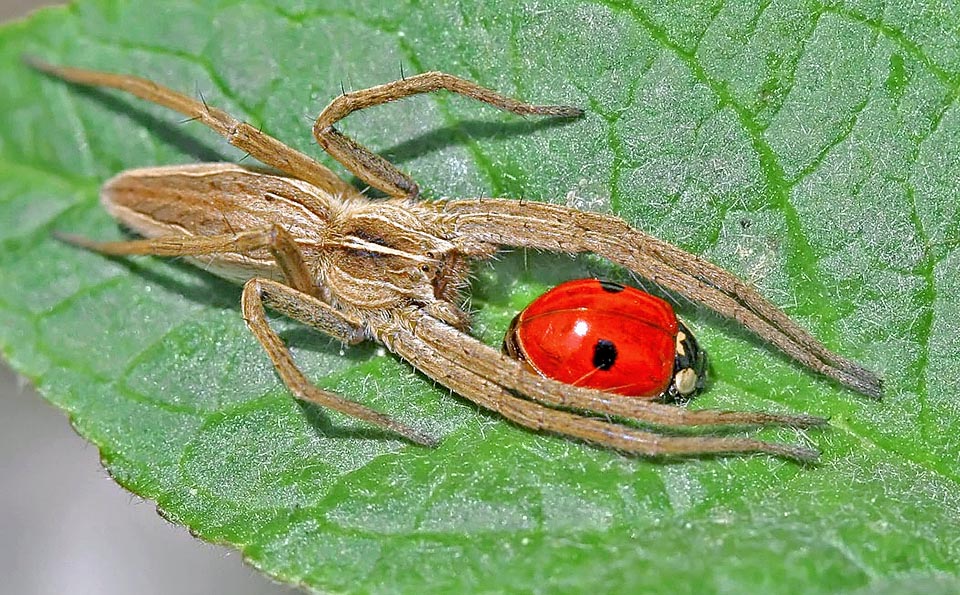
The Two-spot ladybird is mainly predated by birds and by some micromammals but also by insects and spiders like this Pisaura mirabilis © Claude Galand
Biological control and curiosities
Due to its voracity, the Adalia bipunctata is utilized by individuals and professionals in the biological fight for limiting or eliminating the populations of aphids. Its cohabitation with the human being has contributed in making of this ladybird one of the most known by the public along with the Seven-spot ladybird (Coccinella septempunctata). Finally, it is to be noted that the present and important expansion of the Asian ladybeetle (Harmonia axyridis) might cause harm to the local populations of the Two-spot ladybird.
Synonyms
The polymorphism of this species involves a large number of synonyms: Coccinella pantherina Linnaeus, 1758; Coccinella sexputulata Linnaeus, 1758; Coccinella quadrimaculata Scopoli, 1763; Coccinella annulata Voet, 1766; Coccinella cincta O.F. Müller, 1776; Coccinella octoguttata Sulzer, 1776; Coccinella unifasciata Fabricius, 1777; Coccinella tripunctata J. J. Roemer, 1789; Coccinella tripustulata Gmelin, 1790; Coccinella hastata Olivier, 1791; Coccinella dispar D. H. Schneider, 1792; Coccinella frigida D. H. Schneider, 1792; Coccinella arctica Thunberg, 1795; Coccinella varia Schrank, 1798; Coccinella hyperborea Paykull, 1799; Coccinella perforata Marsham, 1802; Coccinella septempustulata Marsham, 1802; Coccinella bisquadripustulata Haworth, 1812; Coccinella bistriverrucata Haworth, 1812; Coccinella quadripunctata Donovan, 1813; Coccinella bioculata Say, 1824; Coccinella humeralis Say, 1824; Coccinella fasciatopunctata Faldermann, 1835; Coccinella disjuncta Randall, 1838; Adonia stictica Mulsant, 1850; Coccinella melanopleura Le Conte, 1859; Adalia (Adalia) ludovicae Mulsant, 1866; Adalia (Adalia) revelieri Mulsant, 1866; Coccinella annectens Crotch, 1873; Adalia (Adalia) concolor Wimmel, 1894; Adalia (Adalia) ornatella Casey, 1899; Adalia (Adalia) ovipennis Casey, 1899; Adalia (Adalia) transversalis Casey, 1899; Adalia (Adalia) similata Gabriel, 1905; Adalia (Adalia) coloradensis Casey, 1908.
→ For general notions about Coleoptera please click here.
→ To appreciate the biodiversity within the BEETLES please click here.
